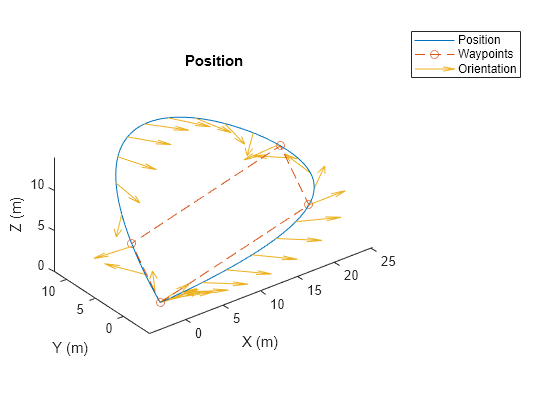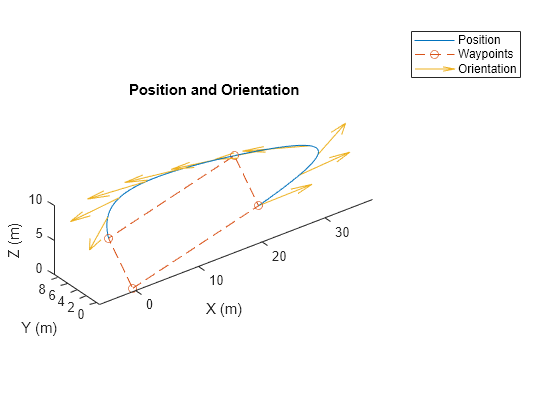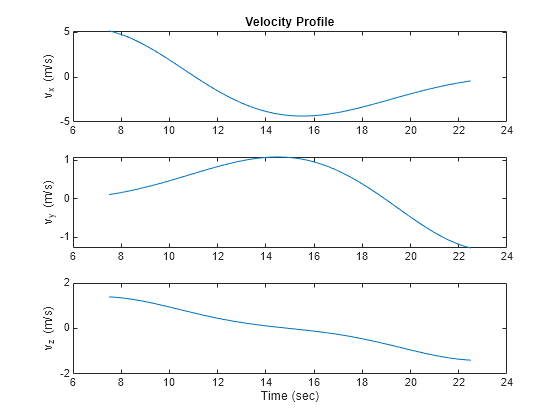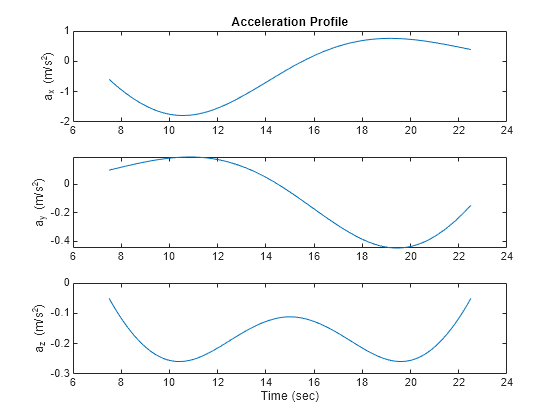polynomialTrajectory
Description
The polynomialTrajectory
System object™ generates trajectories using a specified piecewise polynomial.
You can create a piecewise-polynomial structure using trajectory
generators like minjerkpolytraj, minsnappolytraj, and cubicpolytraj,
as well as any custom trajectory generator. You can then pass the structure to the
polynomialTrajectory
System object to create a trajectory interface for scenario simulation using the robotScenario
object.
To generate a trajectory from a piecewise polynomial:
Create the
polynomialTrajectoryobject and set its properties.Call the object with arguments, as if it were a function.
To learn more about how System objects work, see What Are System Objects?
Creation
Description
Input Arguments
Piecewise polynomial, specified as a structure that defines the polynomial for each section of the piecewise trajectory.
Data Types: struct
Properties
Unless otherwise indicated, properties are nontunable, which means you cannot change their
values after calling the object. Objects lock when you call them, and the
release function unlocks them.
If a property is tunable, you can change its value at any time.
For more information on changing property values, see System Design in MATLAB Using System Objects.
Sample rate of the trajectory in Hz, specified as a positive scalar.
Tunable: Yes
Data Types: double
Number of samples per output frame, specified as a positive integer.
Data Types: double
Orientation at each waypoint, specified as an N-element quaternion column vector
or 3-by-3-by-N array of real numbers. N is the
number of waypoints.
Each quaternion must have a norm of 1. Each
3-by-3 rotation matrix must be an orthonormal matrix. Each quaternion or rotation matrix
is a frame rotation from the local navigation coordinate system to the current body
coordinate system at the corresponding waypoint.
If you do not specify this property, then the object sets yaw to the direction of travel at each waypoint, and pitch and roll are subject to the values of the AutoPitch and AutoBank properties, respectively.
Data Types: double
This property is read-only.
Positions in the navigation coordinate system, in meters, specified as an N-by-3 matrix. The columns of the matrix correspond to the first, second, and third axes, respectively. The rows of the matrix, N, correspond to individual waypoints.
The object infers this value from the piecewise polynomial
pp.
Data Types: double
This property is read-only.
Timestamp at each waypoint, in seconds, specified as an N-element column vector. The number of samples, N, is the same as the number of samples (rows) in Waypoints property. The value of each element of the vector must be greater than the value of the previous element.
The object infers this value from the piecewise polynomial
pp.
Data Types: double
Align the pitch angle with the direction of motion, specified as a logical
0 (false) or 1
(true). When specified as true, the pitch angle
automatically aligns with the direction of motion. If specified as
false, the object sets the pitch angle to 0
(level orientation).
Dependencies
To set this property, you must not specify the Orientation property.
Data Types: logical
Align the roll angle to counteract the centripetal force, specified as a logical
0 (false) or 1
(true). When specified as true, the roll angle
automatically counteracts the centripetal force. If specified as
false, the object sets the roll angle to 0 (flat
orientation).
Dependencies
To set this property, you must not specify the Orientation property.
Data Types: logical
Reference frame of the trajectory, specified as "NED"
(North-East-Down) or "ENU" (East-North-Up).
Data Types: char | string
This property is read-only.
Velocity in the navigation coordinate system at each waypoint, in meters per second, specified as an N-by-3 matrix. The columns of the matrix correspond to the first, second, and third axes, respectively. The number of samples, N, is the same as the number of samples (rows) in Waypoints property.
The object infers this value from the derivative of the piecewise polynomial
pp.
Data Types: double
This property is read-only.
Horizontal direction of travel, in degrees, specified as an N-element real vector. The number of samples, N, is the same as the number of samples (rows) in Waypoints property.
The object infers this value from the derivative of the piecewise polynomial
pp.
Data Types: double
This property is read-only.
Groundspeed at each waypoint, in meters per second, specified as an N-element real vector. The number of samples, N, is the same as the number of samples (rows) in Waypoints property.
The object infers this value from the derivative of the piecewise polynomial
pp.
Data Types: double
This property is read-only.
Climb Rate at each waypoint, in meters per second, specified as an N-element real vector. The number of samples, N, is the same as the number of samples (rows) in Waypoints property.
The object infers this value from the derivative of the piecewise polynomial
pp.
Data Types: double
Usage
Description
[
outputs a frame of trajectory data based on specified creation arguments and properties.
The trajectory returns position,orientation,velocity,acceleration,angularVelocity] = trajectory()NaN for positions and orientations outside the
range of the time of arrival.
Output Arguments
Position in the local navigation coordinate system, returned as an M-by-3 matrix in meters.
M is specified by the SamplesPerFrame property.
Data Types: double
Orientation in the local navigation coordinate system, returned as an
M-element quaternion column
vector or a 3-by-3-by-M real array.
Each quaternion or 3-by-3 rotation matrix is a frame rotation from the local navigation coordinate system to the current body coordinate system at the corresponding sample.
M is specified by the SamplesPerFrame property.
Note
If the consecutive roots of the velocity polynomial are within 1e-3 seconds of each other, indicating a sudden change in direction, then the calculated orientation between these roots will be adjusted to maintain continuity.
Data Types: double
Velocity in the local navigation coordinate system, returned as an M-by-3 matrix, in meters per second.
M is specified by the SamplesPerFrame property.
Data Types: double
Acceleration in the local navigation coordinate system, returned as an M-by-3 matrix, in meters per second squared.
M is specified by the SamplesPerFrame property.
Data Types: double
Angular velocity in the local navigation coordinate system, returned as an M-by-3 matrix, in radians per second.
M is specified by the SamplesPerFrame property.
Data Types: double
Object Functions
To use an object function, specify the
System object as the first input argument. For
example, to release system resources of a System object named obj, use
this syntax:
release(obj)
lookupPose | Obtain pose information for certain time |
waypointInfo | Get waypoint information table |
Examples
Use the minjerkpolytraj function to generate the piecewise polynomial and the time samples for the specified waypoints of a trajectory.
waypoints = [0 20 20 0 0; 0 0 5 5 0; 0 5 10 5 0]; timePoints = cumsum([0 10 1.25*pi 10 1.25*pi]); numSamples = 100; [~,~,~,~,pp,~,tsamples] = minjerkpolytraj(waypoints,timePoints,numSamples);
Use the polynomialTrajectory System object™ to generate a trajectory from the piecewise polynomial that a multirotor must follow. Specify the sample rate of the trajectory and the orientation at each waypoint.
eulerAngles = [0 0 0; 0 0 0; 180 0 0; 180 0 0; 0 0 0]; q = quaternion(eulerAngles,"eulerd","ZYX","frame"); traj = polynomialTrajectory(pp,SampleRate=100,Orientation=q);
Inspect the waypoints, times of arrival, and orientation by using waypointInfo.
waypointInfo(traj)
ans=5×3 table
TimeOfArrival Waypoints Orientation
_____________ ________________________________________ ________________
0 0 0 0 {1×1 quaternion}
10 20 0 5 {1×1 quaternion}
13.927 20 5 10 {1×1 quaternion}
23.927 0 5 5 {1×1 quaternion}
27.854 6.8449e-14 -1.2168e-13 -6.4837e-14 {1×1 quaternion}
Obtain pose information one buffer frame at a time.
[pos,orient,vel,acc,angvel] = traj(); i = 1; spf = traj.SamplesPerFrame; while ~isDone(traj) idx = (i+1):(i+spf); [pos(idx,:),orient(idx,:), ... vel(idx,:),acc(idx,:),angvel(idx,:)] = traj(); i = i + spf; end
Get the yaw angle from the orientation.
eulOrientation = quat2eul(orient); yawAngle = eulOrientation(:,1);
Plot the generated positions and orientations, as well as the specified waypoints.
plot3(pos(:,1),pos(:,2),pos(:,3), ... waypoints(1,:),waypoints(2,:),waypoints(3,:),"--o") hold on % Plot the yaw using quiver. quiverIdx = 1:100:length(pos); quiver3(pos(quiverIdx,1),pos(quiverIdx,2),pos(quiverIdx,3), ... cos(yawAngle(quiverIdx)),sin(yawAngle(quiverIdx)), ... zeros(numel(quiverIdx),1)) title("Position") xlabel("X (m)") ylabel("Y (m)") zlabel("Z (m)") legend({"Position","Waypoints","Orientation"}) axis equal hold off

Use the minsnappolytraj function to generate the piecewise polynomial and the time samples for the specified waypoints of a trajectory.
waypoints = [0 20 20 0 0; 0 0 5 5 0; 0 5 10 5 0]; timePoints = linspace(0,30,5); numSamples = 100; [~,~,~,~,~,pp,~,~] = minsnappolytraj(waypoints,timePoints,numSamples);
Use the polynomialTrajectory System object™ to generate a trajectory from the piecewise polynomial. Specify the sample rate of the trajectory.
traj = polynomialTrajectory(pp,SampleRate=100);
Inspect the waypoints and times of arrival by using waypointInfo.
waypointInfo(traj)
ans=5×2 table
TimeOfArrival Waypoints
_____________ ________________________________________
0 0 0 0
7.5 20 0 5
15 20 5 10
22.5 0 5 5
30 6.5364e-14 -2.6699e-12 -2.8679e-12
Obtain the time of arrival between the second and fourth waypoint. Create timestamps to sample the trajectory.
t0 = traj.TimeOfArrival(2); tf = traj.TimeOfArrival(4); sampleTimes = linspace(t0,tf,1000);
Obtain the position, orientation, velocity, and acceleration information at the sampled timestamps using the lookupPose object function.
[pos,orient,vel,accel,~] = lookupPose(traj,sampleTimes);
Get the yaw angle from the orientation.
eulOrientation = quat2eul(orient); yawAngle = eulOrientation(:,1);
Plot the generated positions and orientations, as well as the specified waypoints.
plot3(pos(:,1),pos(:,2),pos(:,3), ... waypoints(1,:),waypoints(2,:),waypoints(3,:),"--o") hold on % Plot the yaw using quiver. quiverIdx = 1:100:length(pos); quiver3(pos(quiverIdx,1),pos(quiverIdx,2),pos(quiverIdx,3), ... cos(yawAngle(quiverIdx)),sin(yawAngle(quiverIdx)), ... zeros(numel(quiverIdx),1)) title("Position and Orientation") xlabel("X (m)") ylabel("Y (m)") zlabel("Z (m)") legend({"Position","Waypoints","Orientation"}) axis equal hold off

Plot the velocity profiles.
figure subplot(3,1,1) plot(sampleTimes,vel(:,1)) title("Velocity Profile") ylabel("v_x (m/s)") subplot(3,1,2) plot(sampleTimes,vel(:,2)) ylabel("v_y (m/s)") subplot(3,1,3) plot(sampleTimes,vel(:,3)) ylabel("v_z (m/s)") xlabel("Time (sec)")

Plot the acceleration profiles.
figure subplot(3,1,1) plot(sampleTimes,accel(:,1)) title("Acceleration Profile") ylabel("a_x (m/s^2)") subplot(3,1,2) plot(sampleTimes,accel(:,2)) ylabel("a_y (m/s^2)") subplot(3,1,3) plot(sampleTimes,accel(:,3)) ylabel("a_z (m/s^2)") xlabel("Time (sec)")

Extended Capabilities
C/C++ Code Generation
Generate C and C++ code using MATLAB® Coder™.
Version History
Introduced in R2023a
MATLAB Command
You clicked a link that corresponds to this MATLAB command:
Run the command by entering it in the MATLAB Command Window. Web browsers do not support MATLAB commands.
选择网站
选择网站以获取翻译的可用内容,以及查看当地活动和优惠。根据您的位置,我们建议您选择:。
您也可以从以下列表中选择网站:
如何获得最佳网站性能
选择中国网站(中文或英文)以获得最佳网站性能。其他 MathWorks 国家/地区网站并未针对您所在位置的访问进行优化。
美洲
- América Latina (Español)
- Canada (English)
- United States (English)
欧洲
- Belgium (English)
- Denmark (English)
- Deutschland (Deutsch)
- España (Español)
- Finland (English)
- France (Français)
- Ireland (English)
- Italia (Italiano)
- Luxembourg (English)
- Netherlands (English)
- Norway (English)
- Österreich (Deutsch)
- Portugal (English)
- Sweden (English)
- Switzerland
- United Kingdom (English)